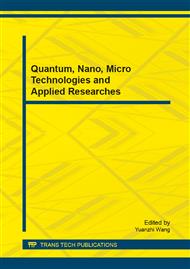p.98
p.102
p.108
p.117
p.121
p.125
p.129
p.133
p.137
The Effects of Nitrogen Concentration in TiNx and the Thickness of HfSiOxN to the Tunneling Currents in Isotropic TiNx/HfSiOxN/SiO2/Si(100) Capacitors
Abstract:
In this paper, we have computed electron tunneling currents in TiNx/HfSiOxN/SiO2/Si (100) MOS capacitors by including a coupling term between transverse and longitudinal kinetic energies which is represented by an electron phase velocity in the gate. The effective mass of the substrate is considered as an isotropic mass. The transmittance was analytically calculated by employing an Airy-wavefunction approach, and the obtained transmittance was then utilized to calculate the tunneling current for different nitrogen compositions in the TiNx metal gate and the equivalent oxide thicknesses (EOTs) of HfSiOxN. It was shown that the tunneling current reduces considerably as the nitrogen composition of the TiNx metal gate decreases. It was also shown that the increase in the EOT reduces the tunneling current. In addition, the tunneling current shows an oscillatory behavior at high oxide voltages.
Info:
Periodical:
Pages:
121-124
Citation:
Online since:
December 2013
Price:
Сopyright:
© 2014 Trans Tech Publications Ltd. All Rights Reserved
Share:
Citation:


